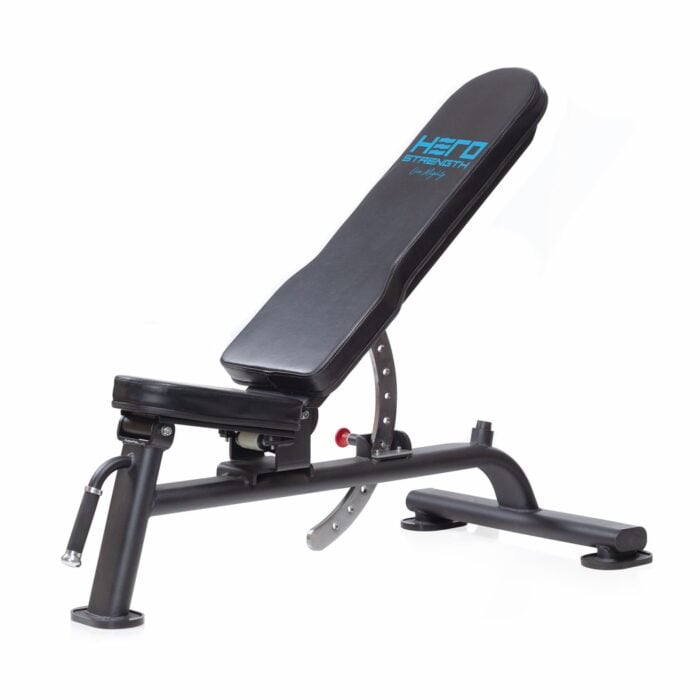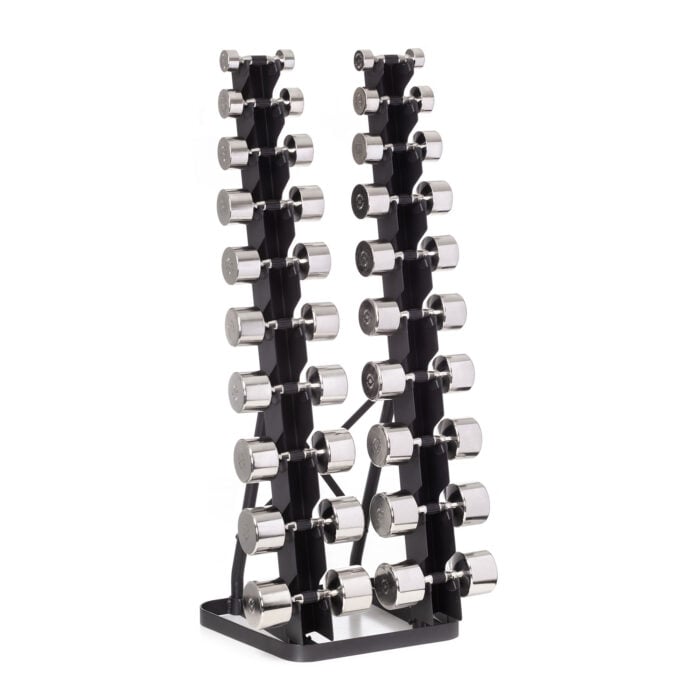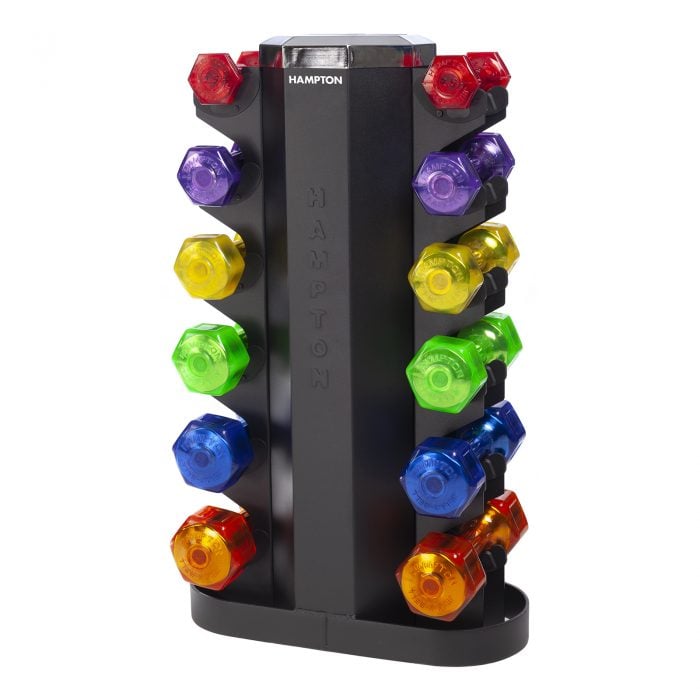If you’re new to fitness, you may wonder why some people prefer cable machines while others remain dedicated to dumbbells. Both options have their advantages but also depend on your unique fitness goals. This post will break down the differences and help you decide what’s best for your fitness plan.
Key Takeaways
- Choosing cables or dumbbells depends on your own fitness goals.
- Cables provide consistency and a greater range of motion.
- Dumbbells offer a versatile experience and the ability to zero in on stabilizer muscles.
Cable Machines Versus Dumbbells
Cable machines and dumbbells are both tools used for muscle building. It’s important to note that while both are effective, they are indeed different. Let’s examine how they compare and why you might choose one over the other.
Cable Machines
When you think of cable machines, you may envision a bustling gym with many large and sometimes overwhelming pieces of equipment available. It’s true. These machines are a staple at gyms and fitness centers across the globe. While they aren’t necessary for getting the best burn, they have some benefits. They offer a controlled and practical approach to strength training for beginners and seasoned gym-goers alike. Are cable machines better than dumbbells? Let’s discuss this.
Cable machines consist of a steel frame, a stack of weights, pulleys, and cables. The cables provide consistent and controlled resistance through each repetition. Cable machines are great for targeting a wide range of muscle groups and allow users to get a functional workout with multi-joint movements resembling everyday actions.
Cable machines also do an excellent job of promoting unilateral training. This type of training is necessary for working out even the most minor muscle imbalances. In this instance, cables act as an assistant for balance and coordination during unilateral training.
Cable machines are versatile and valuable; however, they are limited to specific movements, so they inherently limit the diversity of your workout. They can also be costly for the home user (and definitely more expensive than dumbbells). An extensive and costly fitness machine isn’t necessary to see results from your training program.
Additionally, when it comes to progression, you can adjust your weight stack; however, there’s a caveat. When you progress using dumbbells, you can make more specific and minor tweaks on the fly simply by grabbing another set of dumbbells in a different weight. This process is much easier than on a cable machine.
Finally, cable machines are often more intimidating than dumbbells. Dumbbells are often the better way to begin strength training because they are very user-friendly. Let’s learn more about training with dumbbells, a space and cost-conscious alternative to cables that deliver excellent results.
Dumbbells
Dumbbell training is a traditional and widely accepted method of building strength. This type of training is an excellent way for people of all fitness levels to improve their health and well-being. Dumbbells are commonly made with steel, cast iron, plastic, or concrete; they are typically coated or plated in rubber, urethane, chrome, or neoprene, offering versatility and customization based on personal preference.
Dumbbells are great for activating stabilizer muscles. This activation is essential for achieving better balance and coordination. Unlike cable machines, dumbbells require the user to control the weight throughout the entire range of motion. This level of control forces the smaller supporting muscles to engage, improving overall strength, injury reduction, and joint stability.
Dumbbells offer more freedom than cable machines. In some ways, that’s obvious. They are less expensive, space-saving, and very portable. It’s also important to note that dumbbells allow users to tailor their workouts toward specific goals and the ability to perform a more extensive lineup of exercises than cable machines. Dumbbells are also easily adjusted in weight, allowing you to quickly switch between weights or use two weights simultaneously.
Like the cable machine, dumbbell training will allow the user to perform unilateral work, which should resolve muscular imbalances. Unilateral training is an essential piece of a well-rounded fitness program. They are also suitable for pushing the bar on balance and coordination.
Unilateral training promotes core stability, preventing injury and improving overall body stability and strength. Unilateral training also allows individuals to train according to specific needs and goals. Dumbbells (without machine guidance) will ensure you are mindful of staying balanced and perfecting form to reduce injury. Dumbbells are highly adaptable and perfect for all fitness levels.
Recommended products
Benefits of Free Weights
First, let’s clear up some semantics; dumbbells are free weights. These terms are interchangeable in fitness, so don’t overthink it. As you focus on building muscle, it’s essential to understand the “why” behind the benefits of your gym equipment. Let’s review why free weights are better than weight machines (specifically cable) for most people when building muscle.
- Range of Motion: Free weights promote unrestricted movement. Improved range of motion will allow you to hone in on those functional exercises that mimic how our bodies move to complete daily tasks.
- Activating Stabilizer Muscles: When you choose dumbbells, you’re required to stabilize and control the weight without the help of a machine. This stabilization will engage your supporting muscles; and, as a result, produce better balance, coordination, and overall strength.
- Adaptability: Dumbbells can perform various exercises, including lower body, upper body, core, and total body programs.
- Progression: When you’re committed to the long game of fitness, you must be ready to pivot! Dumbbells offer an easy way to progress or drop weight when necessary.
- Unilateral Training: Dumbbells help perform single-arm or single-leg exercises to solve imbalances while promoting well-rounded strength. While this is also something cable machines can do, dumbbells allow for more specific types of movement during unilateral training.
- Cost Effectiveness: Dumbbells are more affordable than cable machines (or any other gym machine). They are a budget-conscious option for those who want to invest in their fitness. Dumbbells make starting a new fitness program easily attainable. As you build muscle, you’ll need to acquire heavier dumbbells. Purchasing dumbbells incrementally, as you need them, is an excellent way to break down expenses by only buying what you need as you need it.
- Space Saving: Free weights are easy to move around and store. This idea is great for those who want a home gym but need more space. Dumbbells are easily stowed in a corner, under a bed, in a closet, or on a small rack.
- Portability: When you are committed to your fitness journey and start building strength, it’s essential to remain consistent with your workout program. Dumbbells are portable and can go wherever you go.
- Great for all Fitness Levels: One of the nice things about dumbbells is they are not as intimidating as large machines. They are very user-friendly, have a much smaller learning curve, and are great for people of all fitness levels and all ages.
- Improved Bone Density: Regular training with free weights can help improve your bone density, thus lowering the risk of osteoporosis.
Weight Training With Free Weights
As you work toward building muscle by weight training with free weights, you’ll want to have a focused plan that helps you reach your goals. To build muscle mass, use a progressive resistance training (strength training) program that targets multiple muscle groups and includes compound exercises. These exercises will cover numerous joints and muscles throughout your body. As a result, muscle growth will stimulate, promoting strength and improving muscular function for everyday tasks and exercise.
To use your time best, start with challenging but manageable weights for your current fitness level. No matter how familiar you are with a particular exercise, paying attention to your form and technique is always vital. You can invest in an inexpensive full-length mirror to monitor your form as you work out.
Focus on incorporating compound exercises such as dumbbell squats, weighted lunges, bent-over rows, chest presses, and shoulder presses. These exercises target various muscle groups and stimulate muscle growth. Always rest between sets (approximately 60-90 seconds) and between workouts (48-72 hours) per muscle group. This timing will help with recovery and muscle group.
Remember that weight training is only one piece of building healthy muscles. Always complement your lifting session with proper nutrition, hydration, and sleep!
Building Muscle With Dumbbells Exercises
If you need help with how to begin incorporating dumbbell exercises into your routine for a safe and effective muscle-building workout, we can help. We’ve prepared a total-body circuit workout for you. You can do this workout with dumbbells at home and in the gym. You can also take it with you when you travel! We recommend three weights (light, medium, and heavy). What that means will be different for each person. We recommend a set of each 5lb, 8lb, and 10lb weights if you’re starting with dumbbell exercises. As you progress, your weights may look like 12lb, 17.5lb, and 25 lbs.
This total body workout consists of eight exercises. Go through the entire circuit once. Rest for one to two minutes, then repeat. You can do each exercise for reps or time, your choice. Suggested rep goals are listed next to each activity. Feel free to modify each to your fitness level and goals. If you prefer a more advanced workout, increase the number of reps and repeat the circuit as many times as possible while maintaining your form.
Be sure to warm up before you get started and cool down afterward. Taking the time to start and complete your workout correctly will lessen the chance of injury and unnecessary pain.
Goblet Squat (12 reps or 45 seconds)
- Hold a dumbbell vertically with both hands at chest level, with feet shoulder-width apart.
- Lower into a squat by bending your knees and pushing your hips back; Keep your chest up and back straight.
- Push through your heels to return to the starting position.
Bent-Over Row (12 reps or 45 seconds)
- Hold a dumbbell in each hand, bend your knees slightly, and hinge forward at the hips, maintaining a straight back.
- Pull the dumbbells up toward your ribcage, keeping your elbows close to your body.
- Lower the dumbbells back down to the starting position.
- Alternating Reverse Lunge (12 reps each leg or 45 seconds per leg)
- Hold a dumbbell in each hand at your sides, and stand with your feet hip-width apart.
- Step back with one foot and lower into a lunge, keeping the front knee behind your toes.
- Push through your front heel to return to the starting position and repeat on the other side.
Dumbbell Chest Press (12 reps or 45 seconds)
- Lie on a bench or the floor with a dumbbell in each hand, elbows bent at a 90-degree angle and aligned with your shoulders.
- Press the dumbbells until your arms are fully extended, then lower them back to the starting position.
Romanian Deadlift (12 reps or 45 seconds)
- Hold a dumbbell in each hand with your feet hip-width apart and a slight bend in your knees.
- Hinge at your hips and lower the dumbbells toward the floor, maintaining a straight back.
- Squeeze your glutes and engage your hamstrings to return to the starting position.
Dumbbell Bicep Curl (12 reps or 45 seconds)
- Hold a dumbbell in each hand with palms facing forward, and arms extended down.
- Curl the dumbbells toward your shoulders, keeping your elbows stationary.
- Lower the dumbbells back down to the starting position.
Dumbbell Overhead Tricep Extension (12 reps or 45 seconds)
- Hold a dumbbell vertically with both hands above your head, arms fully extended.
- Bend your elbows to lower the dumbbell behind your head, keeping your upper arms stationary.
- Extend your arms to return to the starting position.
Dumbbell Renegade Row (12 reps on each side or 45 seconds per side)
- Start in a plank position with a dumbbell in each hand, positioned beneath your shoulders.
- While keeping your core tight and hips stable, row one dumbbell toward your ribcage.
- Lower the dumbbell back down and repeat on the other side.
Take Your Dumbbell Workouts to the Next Level With Hampton Fitness.
As we wrap up, it’s important to note that dumbbells and cable machines offer unique benefits. Technically, there isn’t a right or wrong answer when choosing dumbbells vs. cable machines; however, dumbbells are often preferable because they are versatile, adaptable, and affordable for all fitness levels. If you’ve been committed to gym machines, consider branching out and incorporating more dumbbell workouts into your routine.
A set of dumbbells from Hampton Fitness can help you take your training to the next level, adding variety, functionality, and well-rounded muscle development.
Check out our website for our expansive range of dumbbells in various styles, colors, and materials. We look forward to helping build a more robust and healthier you!





